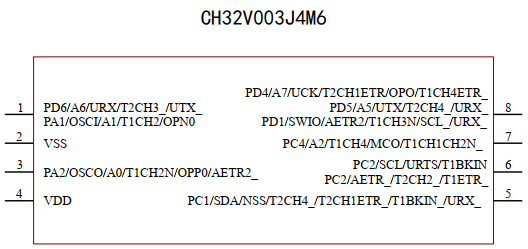关于GPIO合封引脚以及晶振引脚使用注意事项
CH32系列某些小封装芯片可能会存在合封引脚,如下图。以下图8脚为例,为PD4、PD5、PD1的合封引脚,其中PD1引脚还作为SWIO下载引脚。若要使用PD4引脚作为普通IO输出高低电平,注意在进行程序配置时需要注意:
(1)PD4引脚按照GPIO输出配置;
(2)合封引脚PD5和PD1要配置为浮空输入模式;
(3)PD1同时作为SWIO下载引脚,要注意关闭SDI下载功能,要注意开启复用时钟,即AFIO时钟。

PD4引脚作为普通IO使用配置代码如下:
/********************************** (C) COPYRIGHT ******************************* * File Name : main.c * Author : WCH * Version : V1.0.0 * Date : 2023/12/25 * Description : Main program body. ********************************************************************************* * Copyright (c) 2021 Nanjing Qinheng Microelectronics Co., Ltd. * Attention: This software (modified or not) and binary are used for * microcontroller manufactured by Nanjing Qinheng Microelectronics. *******************************************************************************/ /* *@Note *Multiprocessor communication mode routine: *Master:USART1_Tx(PD5)\USART1_Rx(PD6). *This routine demonstrates that USART1 receives the data sent by CH341 and inverts *it and sends it (baud rate 115200). * *Hardware connection:PD5 -- Rx * PD6 -- Tx * */ #include "debug.h" /* Global define */ /* Global Variable */ /********************************************************************* * @fn USARTx_CFG * * @brief Initializes the USART2 & USART3 peripheral. * * @return none */ void GPIO_CFG(void) { GPIO_InitTypeDef GPIO_InitStructure = {0}; RCC_APB2PeriphClockCmd(RCC_APB2Periph_GPIOA | RCC_APB2Periph_GPIOD , ENABLE); RCC_APB2PeriphClockCmd(RCC_APB2Periph_AFIO , ENABLE); GPIO_PinRemapConfig(GPIO_Remap_SDI_Disable, ENABLE); GPIO_InitStructure.GPIO_Pin = GPIO_Pin_1; GPIO_InitStructure.GPIO_Speed = GPIO_Speed_30MHz; GPIO_InitStructure.GPIO_Mode = GPIO_Mode_IN_FLOATING; GPIO_Init(GPIOD, &GPIO_InitStructure); GPIO_InitStructure.GPIO_Pin = GPIO_Pin_5; GPIO_InitStructure.GPIO_Speed = GPIO_Speed_30MHz; GPIO_InitStructure.GPIO_Mode = GPIO_Mode_IN_FLOATING; GPIO_Init(GPIOD, &GPIO_InitStructure); GPIO_InitStructure.GPIO_Pin = GPIO_Pin_2; GPIO_InitStructure.GPIO_Speed = GPIO_Speed_30MHz; GPIO_InitStructure.GPIO_Mode = GPIO_Mode_Out_PP; GPIO_Init(GPIOA, &GPIO_InitStructure); GPIO_InitStructure.GPIO_Pin = GPIO_Pin_4; GPIO_InitStructure.GPIO_Speed = GPIO_Speed_30MHz; GPIO_InitStructure.GPIO_Mode = GPIO_Mode_Out_PP; GPIO_Init(GPIOD, &GPIO_InitStructure); } /********************************************************************* * @fn main * * @brief Main program. * * @return none */ int main(void) { u8 i=0,j=0; NVIC_PriorityGroupConfig(NVIC_PriorityGroup_1); SystemCoreClockUpdate(); Delay_Init(); #if (SDI_PRINT == SDI_PR_OPEN) SDI_Printf_Enable(); #else // USART_Printf_Init(115200); #endif // printf("SystemClk:%d\r\n",SystemCoreClock); // printf( "ChipID:%08x\r\n", DBGMCU_GetCHIPID() ); GPIO_CFG(); while(1) { Delay_Ms(50); //延时50ms GPIO_WriteBit(GPIOA, GPIO_Pin_2, (i==0) ? (i=Bit_SET):(i=Bit_RESET)); //设置PA2引脚状态为低电平 Delay_Ms(50); //延时50ms GPIO_WriteBit(GPIOD, GPIO_Pin_4, (j==0) ? (j=Bit_SET):(j=Bit_RESET)); //设置PD4引脚状态为低电平 } }
当使用晶振引脚作为普通GPIO使用时,注意系统主频要切换使用内部晶振进行配置。
分类:
32位MCU学习
标签:
CH32V003;GPIO;合封





【推荐】国内首个AI IDE,深度理解中文开发场景,立即下载体验Trae
【推荐】编程新体验,更懂你的AI,立即体验豆包MarsCode编程助手
【推荐】抖音旗下AI助手豆包,你的智能百科全书,全免费不限次数
【推荐】轻量又高性能的 SSH 工具 IShell:AI 加持,快人一步
· TypeScript + Deepseek 打造卜卦网站:技术与玄学的结合
· Manus的开源复刻OpenManus初探
· AI 智能体引爆开源社区「GitHub 热点速览」
· 从HTTP原因短语缺失研究HTTP/2和HTTP/3的设计差异
· 三行代码完成国际化适配,妙~啊~